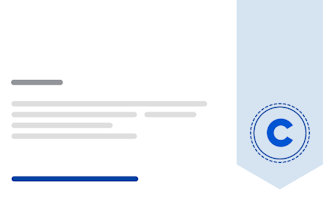How to Use a Product Roadmap
September 27, 2024
Article



This course is part of Financial Reporting Specialization

Instructor: Scott Mendoza
11,565 already enrolled
Included with 
(117 reviews)
Recommended experience
Intermediate level
Introductory understanding of financial accounting.
(117 reviews)
Recommended experience
Intermediate level
Introductory understanding of financial accounting.
Describe the accounting process related to accounting for liabilities (from origination of transactions to disclosure in the financial statements)
Describe liabilities and contingencies and demonstrate the appropriate accounting treatment, including required disclosures
Demonstrate the accounting for bonds (including par, discount, and premium bonds)
Explain and demonstrate the accounting for pension plans

Add to your LinkedIn profile
67 assignments



Add this credential to your LinkedIn profile, resume, or CV
Share it on social media and in your performance review

This course focuses on the recognition, measurement and subsequent accounting for various types of liabilities. The content includes:
- Current liabilities and contingencies, such as accounts payable, accrued expenses, warranties, and pending litigation - Accounting for long-term debt, including the issuance, payment of interest, amortization, and extinguishment of debt instruments. - Lease accounting from the perspective of both the lessee and the lessor - Pension accounting, including the calculation of benefit obligations, plan assets, and net periodic benefit cost We will discuss the relevant accounting standards and principles used to measure and disclose these items in the financial statements. This course is the third course in the Financial Reporting Specialization offered by the University of Illinois at Urbana-Champaign.
In this module, you will become familiar with the course, your instructor and your classmates, and our learning environment. This orientation will also help you obtain the technical skills required to navigate and be successful in this course.
4 videos4 readings1 assignment1 discussion prompt1 plugin
In this module, you will be introduced to the concepts of current liabilities and contingencies. You will learn how to classify liabilities as current or long-term, including consideration of refinancing arrangements. The module also describes the criteria for recognizing and/or disclosing contingencies.
9 videos2 readings10 assignments
In this module, you will be introduced to the concept of long-term debt. You will learn about the different types of bonds and how each type results in different accounting, including bonds sold at a premium or discount. The module also explains the recognition of interest and bond extinguishment.
9 videos2 readings10 assignments
In this module, long-term debt will be discussed in more detail. Students will learn how to account for other aspects of bond accounting, including bond issue costs, fair value accounting, convertible debt, troubled debt restructuring, issuances between interest dates, and differences between U.S. GAAP and IFRS.
11 videos2 readings12 assignments
In this module, you will be introduced to the most recent lease accounting standards issued by the Financial Accounting Standards Board (FASB). Starting with the definition of a lease, this module will discuss features of the model related to both lessors and lessees. It will also illustrate the classification of leases, initial recognition, and subsequent measurement.
7 videos2 readings8 assignments
In this module, we continue the discussion of the lease accounting model. You will learn how to account for leased asset purchase options, leased asset residual values, sale leaseback accounting, and the differences between U.S. GAAP and IFRS when accounting for leases.
9 videos2 readings10 assignments
In this module, you will be introduced to accounting for pension benefits. We will explore the basic features of accounting for defined benefit plans, including benefit obligations, plan assets, and the components of net periodic benefit cost.
7 videos2 readings8 assignments
In this module, you will continue your study of accounting for employee retirement benefits. We will learn how to account for plan amendments and the recognition of pension gains and losses. We will also discuss a comprehensive recognition of pension activities. The module will conclude with a discussion of the major differences between U.S. GAAP and IFRS with respect to pension accounting.
8 videos2 readings8 assignments
This module is for you to tell us what you think of the course.
4 readings1 peer review1 discussion prompt1 plugin
We asked all learners to give feedback on our instructors based on the quality of their teaching style.



The University of Illinois at Urbana-Champaign is a world leader in research, teaching and public engagement, distinguished by the breadth of its programs, broad academic excellence, and internationally renowned faculty and alumni. Illinois serves the world by creating knowledge, preparing students for lives of impact, and finding solutions to critical societal needs.

University of Illinois Urbana-Champaign
Build toward a degree
Course

University of Illinois Urbana-Champaign
Build toward a degree
Course


IE Business School
Course

University of Illinois Urbana-Champaign
Build toward a degree
Course
This course is part of the following degree program(s) offered by University of Illinois Urbana-Champaign. If you are admitted and enroll, your completed coursework may count toward your degree learning and your progress can transfer with you.¹
This course is part of the following degree program(s) offered by University of Illinois Urbana-Champaign. If you are admitted and enroll, your completed coursework may count toward your degree learning and your progress can transfer with you.¹

University of Illinois Urbana-Champaign
Degree · 8 months

University of Illinois Urbana-Champaign
Degree · 1.5 – 3 years
¹Successful application and enrollment are required. Eligibility requirements apply. Each institution determines the number of credits recognized by completing this content that may count towards degree requirements, considering any existing credits you may have. Click on a specific course for more information.




117 reviews
78.63%
12.82%
5.12%
1.70%
1.70%
Showing 3 of 117
Reviewed on Oct 10, 2020
The course was perfect as a whole. Easily understandable lectures. The course contents were extremely good. It helped a lot to improve my understanding on certain topics. Thank you so much.
Reviewed on Jan 21, 2020
This course is very interesting and informative! Great professor
Reviewed on Aug 9, 2020
This course is too hard for me. I will review it after I learn a book.


Unlimited access to 10,000+ world-class courses, hands-on projects, and job-ready certificate programs - all included in your subscription

Earn a degree from world-class universities - 100% online

Upskill your employees to excel in the digital economy
Once you enroll for a Certificate, you’ll have access to all videos, quizzes, and programming assignments (if applicable). If you choose to explore the course without purchasing, you may not be able to access certain assignments.
You will be eligible for a full refund until 2 weeks after your payment date. You cannot receive a refund once you’ve earned a Course Certificate, even if you complete the course within the 2-week refund period. View our full refund policy.
Yes! Coursera provides financial aid to learners who would like to complete a course but cannot afford the course fee. To apply for aid, select "Learn more and apply" in the Financial Aid section below the "Enroll" button. You'll be prompted to complete a simple application; no other paperwork is required.
When you enroll in the course, you get access to all of the courses in the Specialization, and you earn a certificate when you complete the work. Your electronic Certificate will be added to your Accomplishments page - from there, you can print your Certificate or add it to your LinkedIn profile. If you only want to read and view the course content, you can audit the course for free.